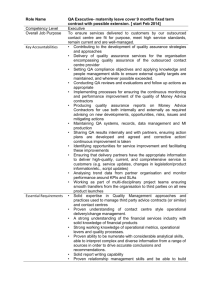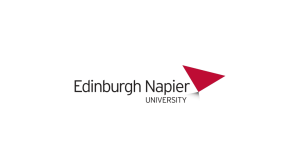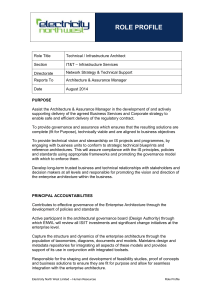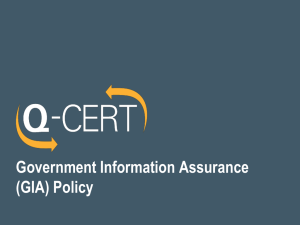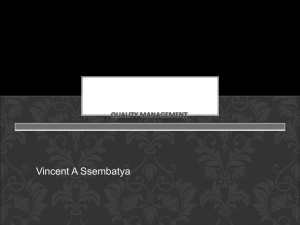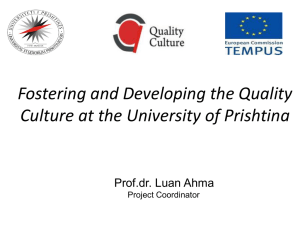Risk and quality committee - North Middlesex University Hospital
advertisement
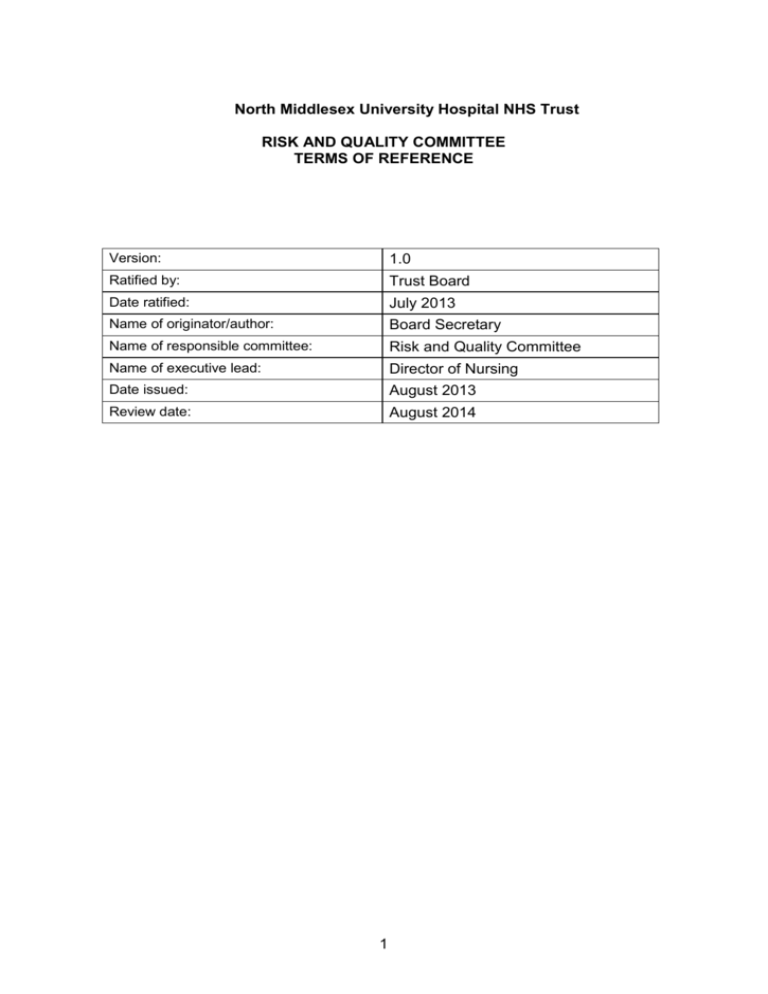
North Middlesex University Hospital NHS Trust RISK AND QUALITY COMMITTEE TERMS OF REFERENCE Version: 1.0 Ratified by: Trust Board Date ratified: July 2013 Name of originator/author: Board Secretary Name of responsible committee: Risk and Quality Committee Name of executive lead: Director of Nursing Date issued: August 2013 Review date: August 2014 1 RISK AND QUALITY COMMITTEE TERMS OF REFERENCE 1 AUTHORITY 1.1 The Risk and Quality Committee is constituted as a Standing Committee of the Board. Its Constitution and Terms of Reference shall be as set out below, subject to amendment by the Board. 1.2 The Committee derives its powers from the Board and has no executive powers, other than those specifically delegated in these Terms of Reference. 1.3 The Committee is authorised by the Board to investigate any activity within its Terms of Reference. It is authorised to seek any information it requires from any member of staff and all members of staff are directed to co-operate with any request made by the Committee. 1.4 The Committee is authorised by the Board to request the attendance of individuals and authorities from outside the Trust with relevant experience and expertise if it considers this necessary. 2 PURPOSE 2.1 The Trust Board is responsible for ensuring robust structures and processes are in place for governing the quality of clinical services and ensuring services are safe. 2.2 The Risk and Quality Committee’s primary role is to provide assurance to the Board on Clinical Quality & Safety, including Clinical Effectiveness, Patient Safety and Patient Experience utilising best practice metrics that provide robust clinical governance processes to deliver safe, high quality and patient centred care. 2.3 Specifically, the Committee will: 2.4 Monitor the Trust’s compliance requirements: 2.5 with statutory and regulatory Care Quality Commission regulations Information Governance Toolkit NHS Constitution NHSLA Equality Act 2010 Best practice guidance including NICE guidance Health and Safety at Work Act 1974. Oversee the development and implementation of the Quality strategy, as well as the Trust’s achievement of quality indicators, including the 2 Quality Accounts declaration. 2.6 To seek assurance that the essential standards of quality and safety (as determined by CQC’s registration requirements) are at a minimum being met by every service that the organisation delivers. 2.7 To ensure that the organisation is striving for continuous quality improvement and outcomes. 2.8 Seek assurance on the Trust’s arrangements for ensuring the best possible clinical outcomes are achieved for patients, whilst monitoring any areas where improvements are required. 2.9 Monitor the Trust’s arrangements for ensuring patients’ views and feedback are captured and where relevant incorporated within service improvements. Monitor the implementation of action plans associated with serious untoward incidents, high risk incidents, serious case reviews and complaints. As part of this process, the Committee will scrutinise and challenge the effectiveness of the Trust’s arrangements for disseminating and implementing learning at Trust level, whilst reviewing assurance on its effectiveness, such as the Francis and Keogh Report. 2.10 3 MEMBERSHIP 3.1 Members of the committee shall be appointed by the Board and shall include two Non Executive Directors of the Board, a patient representative ( and a governor once governors are in place) and senior management consisting of: Director of Nursing Medical Director Director of Operations Head of integrated Governance Associate Medical Directors 3.2 The Committee will be chaired by a Non-Executive Director. 3.3 The Committee will ensure that the patient experience is a core focus of its remit and agenda and will seek a patient representative (and a governor, when appropriate) as a formal Committee Member to provide challenge and assurances that the Committee is addressing the required improvement areas. 3.4 Appointments to the Committee shall be for a period of up to three years, which may be extended for a further three year period, provided the non-executive director concerned remains a member of the Board. 3 4 REPORTING RESPONSIBILITIES 4.1 The Committee Chair shall report formally to the Board on its proceedings after each meeting on all matters within its duties and responsibilities. 4.2 The Committee shall make whatever recommendations to the Board it deems appropriate on any area within its remit where action or improvement is needed. 4.3 The Committee shall oversee the production of an annual report to the Board. 4.4 The Committee shall make available upon request, in a format they deem appropriate, information regarding the attendance of all members at committee meetings. 4.5 The Committee will ensure its groups operate effectively and discharge their roles appropriately through quarterly assurance reports and an annual review of their Terms of Reference. The following groups will report to the Risk and Quality Committee: Clinical Effectiveness and Outcomes Group Patient Experience Group Risk and Safety Group 5 QUORUM 5.1 To ensure the effectiveness of the Committee, the Quorum necessary for the transaction of business shall be four members two of which will include: The Medical Director/designated deputy One Non Executive Director OR Director/designated deputy One Non Executive Director. 5.2 A duly convened meeting of the Committee at which a quorum is present shall be competent to exercise all or any of the authorities, powers and discretions vested in or exercisable by the Committee. 6 FREQUENCY OF MEETINGS 6.1 The Committee shall meet on a bi-monthly basis and otherwise as required. The Chair may request an additional meeting if this is considered that one is necessary. 4 7 NOTICE OF MEETINGS 7.1 The Board Secretary shall undertake the role of Secretary for the Committee. 7.2 Meetings of the committee shall be summoned by the Secretary of the committee at the request of any of its members, subject to the Chairs approval. 7.3 Unless otherwise agreed, notice of each meeting confirming the venue, time and date together with an agenda of items to be discussed, shall be forwarded to each member of the committee, any other person required to attend and all other non-executive directors, no later than five working days before the date of the meeting. Supporting papers shall be sent to committee members and to other attendees as appropriate, at the same time. 8 MINUTES OF MEETINGS 8.1 The Secretary shall minute the proceedings of all meetings of the committee, including recording the names of those present and in attendance. 8.2 The Secretary shall ascertain, at the beginning of each meeting, the existence of any conflicts of interest and minute them accordingly. 8.3 Draft minutes of committee meetings shall be circulated promptly to all members of the committee and, once finalised they will be submitted to the Board. 9 DUTIES 9.1 The duties of the Committee can be categorised as follows: 9.2 Quality 9.2.1 To oversee the development and implementation of the Quality Strategy and associated policies and action plans. 9.2.2 To oversee the organisation’s processes for developing implementing the quality improvement priorities, including: and Monitoring of performance against the related quality indicators Overseeing assurance arrangements for the annual Quality Account declaration. 9.2.3 Seek assurance on the Trust’s arrangements for actively engaging patients, staff and key stakeholders on quality, including their patient experience. 5 9.2.4 Oversee the implementation of quality initiatives, such as High Quality Care for all, whilst monitoring the compliance of the Trust with national and local quality indicators. 9.2.5 Monitor the Trust’s plans for mitigating risks to quality associated with financial and operational initiatives, (such as major service changes, cost improvement plans) whilst ensuring the standards of clinical care are maintained. 9.2.6 To oversee the Trust’s arrangements for maintaining compliance with the Equality Act 2010 requirements including: 9.3 Undertaking of Equality Impact Assessments Monitoring of the Equality and Diversity Action Plan The maintenance of a Single Equality Scheme. Patient Safety 9.3.1 To oversee the Trust’s arrangements for meeting all regulatory and mandated care standards, with robust response and tracking processes in place to meet national alert requirements, national guidelines and relevant external quality and safety standards with a focus on agreed patient sensitive indicators. 9.3.2 To receive an agreed level of patient safety and outcomes data which provides trends and themes from care delivery, utilising clinical metrics to uniform and analyse the range of clinical services across the Trust. 9.3.3 To inform the Board about the level of assurance or risks on the standards of care provided across the range of services, including actions in place to drive improvements and mitigate risks. 9.3.4 To oversee the organisation’s arrangements for maintaining compliance with the Care Quality Commission’s essential standards of Quality and Safety. 9.3.5 To receive and review the annual Patient Safety report. 9.3.6 To receive and review the annual Health and Safety report. 9.4 Incident Reporting and Investigation 9.4.1 To monitor the effectiveness of the Trust's systems for reporting and investigating Serious Incidents (SIs), near misses and high risk incidents. 9.4.2 To review the outcomes of investigations and external inspections, ensuring that the information is presented in sufficient detail to enable systemic failings in patient care to be identified and mitigated in future. 6 9.4.3 To monitor and receive assurance on action plans and progress reports proposed by management in response to SIs, near misses and other incidents. 9.5 Patient Experience 9.5.1 To ensure the organisation meets all its statutory and regulatory obligations in relation to patient experience such as the NHS Constitution rights and pledges of patients. 9.5.2 To oversee the Trust’s programme of patient surveys, and commission additional surveys where further assurance is required. 9.5.3 To monitor the implementation of agreed actions/improvements required to improve the patient experience. 9.5.4 To monitor the effectiveness of the Trust's systems for complaints handling, monitoring the effectiveness of the Trust’s system for advocacy and the encouragement of feedback from patients and relatives. 9.5.5 To monitor patient complaints trends, and the implementation of action plans arising from them, including a review of the Annual Complaints report. 9.5.6 To oversee and monitor action plans resulting from patient surveys. 9.6 Clinical Effectiveness 9.6.1 To receive assurances on the effectiveness of clinical practice through national audits and other external clinical reviews. 9.6.2 To review the effectiveness of the Trust's arrangements for the systematic monitoring of national and local quality indicators, as well as mortality and other patient outcomes. 9.6.3 To approve the annual clinical audit programme and the annual clinical audit report. 9.6.4 To review key clinical audit findings and the action plans proposed by management in response to these. 9.6.5 To commission clinical audits where required to provide additional assurance. 9.6.6 To monitor the implementation of Research and Development initiatives and to receive the Research and Development Annual Report. 7 9.6.7 To approve deviation from NICE Guidance where it is deemed appropriate and necessary to do so. 9.7 Information Governance 9.7.1 To monitor the Trust’s arrangements for complying with statutory and regulatory obligations stemming from the Data Protection Act 1998 and Freedom of Information Act 2000. 9.7.2 To seek ongoing assurance on the Trust’s information risk management arrangements through the Senior Information Risk Owner. 9.7.3 To oversee the implementation of action plans associated with the high risk information governance incidents or Serious Untoward Incidents. 9.7.4 To monitor the implementation of the Information Governance Action Plan, ensuring the Trust meets a minimum compliance level 2 on the Information Governance Toolkit. 9.8 Risk Management and policy oversight 9.8.1 To oversee the implementation of action plans associated with high risk incidents and SIs, whilst monitoring the arrangements in place to ensure any related risks are mitigated to an acceptable level. 9.8.2 To monitor compliance with regulatory requirements such as the NHSLA Risk Management Standards. 9.8.3 To ensure the Trust’s risk management process is live in relation to clinical risk, through the escalation of risks from the Directorate level risk registers to the corporate risk register. In undertaking this role, the Committee will seek assurance from the Risk and Safety Group, whilst maintaining oversight of significant risks via a review of the corporate risk register. 9.8.4 To undertake quarterly monitoring of the Board Assurance Framework in relation to clinical risk. The Committee will review and assess the adequacy of the risk mitigation plans against significant clinical risk. 9.8.5 The Committee will approve policies on behalf of the Board that fall within its remit, advising the Board of any ratifications through the Chair’s assurance report. 9.8.6 Areas that the Committee will be responsible for providing the Board with assurance in relation to include: Clinical Governance Research and Development Governance Management of non financial risk (e.g. Emergency Planning) 8 9.9 Legislative and regulatory compliance Accreditation and assessment (e.g. Commission regulations, NHSLA) Policy Management Framework Data quality. the Care Quality Managing Risks to Quality 9.9.1 In undertaking its role as Quality Committee of the Trust, the Risk and Quality Committee will assess the effectiveness of the organisation’s arrangements for managing risks to quality, taking assurance from the work of the Risk and Safety Group where appropriate. 9.9.2 Reviewing the learning from complaints (upheld and non‐upheld) following a Health Service Ombudsman investigation where recommendations have been made for systemic improvements. 9.9.3 Ensuring the Trust acts on learning from HM Coroner’s Inquest and specifically on Rule 43 decision. 10 MONITORING EFFECTIVENESS 10.1 The constitution, Terms of Reference and progress of the Committee shall be reviewed annually, or revised as part of the Trust’s progression to Foundation Trust status. 10.2 The Committee will review its own performance and Terms of Reference to ensure it is operating at maximum effectiveness and recommend any changes it considers necessary to the Board for approval, on an annual basis. 10.3 The Committee will establish an annual work programme which will be submitted to the Board for approval as part of the assurance arrangements. 10.4 In particular, the annual programme coverage will incorporate all key areas within the Committee’s duties, as set out in section 9 of its Terms of Reference. 10.5 The Committee will receive the annual workplans of its groups, and assurance updates on progress quarterly 9
